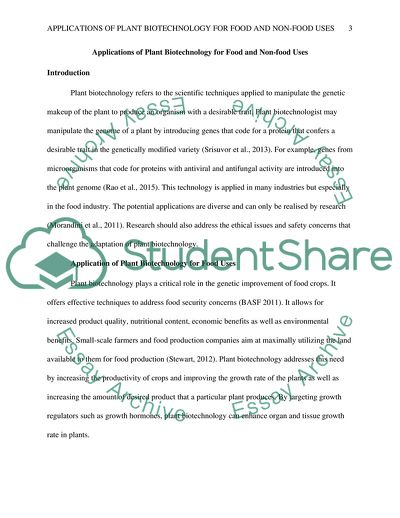Cite this document
(Applications of Plant Biotechnology for Food and Non-Food Uses Research Paper, n.d.)
Applications of Plant Biotechnology for Food and Non-Food Uses Research Paper. Retrieved from https://studentshare.org/biology/1868492-1-microbial-exo-polysaccharides-their-functions-industrial-applications-food-non-food-biotechnology-2-the-application-of-plant-biotechnology-for-food-non-food-uses-3-the-production-of-galactosidase-from-plant-food-wastes
Applications of Plant Biotechnology for Food and Non-Food Uses Research Paper. Retrieved from https://studentshare.org/biology/1868492-1-microbial-exo-polysaccharides-their-functions-industrial-applications-food-non-food-biotechnology-2-the-application-of-plant-biotechnology-for-food-non-food-uses-3-the-production-of-galactosidase-from-plant-food-wastes
(Applications of Plant Biotechnology for Food and Non-Food Uses Research Paper)
Applications of Plant Biotechnology for Food and Non-Food Uses Research Paper. https://studentshare.org/biology/1868492-1-microbial-exo-polysaccharides-their-functions-industrial-applications-food-non-food-biotechnology-2-the-application-of-plant-biotechnology-for-food-non-food-uses-3-the-production-of-galactosidase-from-plant-food-wastes.
Applications of Plant Biotechnology for Food and Non-Food Uses Research Paper. https://studentshare.org/biology/1868492-1-microbial-exo-polysaccharides-their-functions-industrial-applications-food-non-food-biotechnology-2-the-application-of-plant-biotechnology-for-food-non-food-uses-3-the-production-of-galactosidase-from-plant-food-wastes.
“Applications of Plant Biotechnology for Food and Non-Food Uses Research Paper”. https://studentshare.org/biology/1868492-1-microbial-exo-polysaccharides-their-functions-industrial-applications-food-non-food-biotechnology-2-the-application-of-plant-biotechnology-for-food-non-food-uses-3-the-production-of-galactosidase-from-plant-food-wastes.


